Kirsten Hastrup
27 May 2013
Qaanaaq, North West Greenland.
This time my main objective was to finally visit old Thule – previous attempts had failed due to unpredictable weather. The helicopter actually flew as planned this time, even though we could not take the regular route, due to fog and heavy winds over the icecap. We had to keep low, close to the partially ice-covered sea and follow the coastline around several headlands and glaciers for almost an hour. It gave an exquisite view of the world in which we were immersed.

The stay allowed us – my friend and local guide, Hans, and myself – time, light, solitude, and emotional space enough for sensing the place, until then only mythological for me. On the narrow strip of land connecting the emblematic Thule-mountain, Uummanaaq, meaning ‘the heart-shaped’, and the mainland, there were remnants of both the old turf-huts and of the trading station built in 1910 (pictures 1, 2). The original settlement was worn down and almost disappearing, but exploring the area and counting some 15 ruins’ – and knowing the history of course – I commiserated with the c. 130 people who were forced to relocate in 1953 because of the US Airbase, and were left no time to pack up all of their belongings.
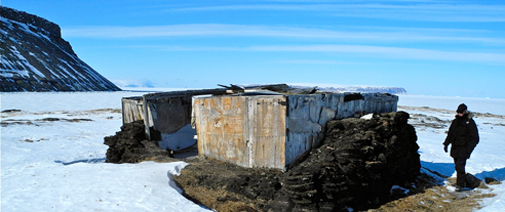
Our return journey again brought us along the coast, passing the now abandoned settlement of Moriussaq (picture 3). The last person to leave was the shopkeeper, who left in 2011, after having been on his own for three years. The now empty settlement added to the feeling of dystopia that marked my first weeks here.
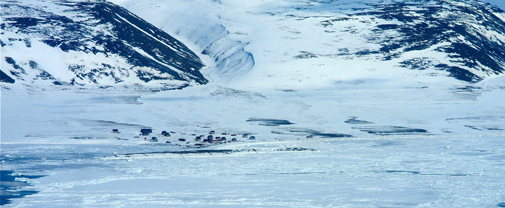
My second objective presented itself rather forcefully and concerned the halibut fishing that suddenly took off. It had been very promising last year, but the fish-factory (essentially a freezing plant), had gone broke over winter, so fishing had stopped completely, except for private consumption. One day we heard on the radio, that it would reopen, and ‘big scale’ fishing started immediately. Sledges went out, holes were made, long lines with up to a hundred hooks were dropped, and the heaps of fish grew on the sea-ice. There was an immediate sense of opportunity, and of a reclaimed future. Time is short, however, because the ice may soon break up and put a long seasonal stop to this kind of fishing. There were at least 20 fishing stations on the fjord, some with several lines – meaning that people had now totally embraced the idea of fishing. I walked many miles to go back and forth, sometime witnessing also very meagre results (picture 4).
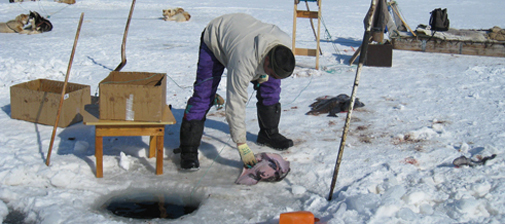
The invisible prey is not an easy catch up here, yet people seem very resilient, and this time I have seen more young men than ever before taking part in hunting and fishing – probably anticipating some kind of future for themselves in this wonderful but very demanding place.
24 January 2013
Qaanaaq, North West Greeland
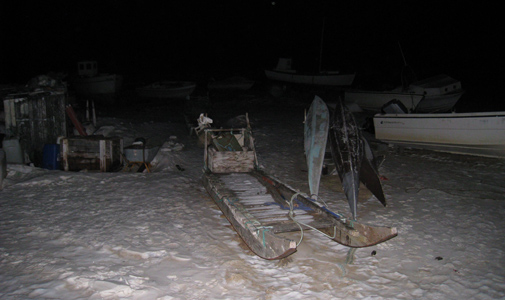
Back again in North West Greenland, I quickly settled in with my old hosts in Qaanaaq, home to some 600 people. My own sense of homecoming was tempered by the fact that this was my first visit during the Polar Night, and the sights were entirely different. Arriving in early January meant that darkness reigned, and with temperatures mostly around -250 C, the world seemed deep-frozen and totally still (picture 1). There was no view across the fjord, no sense of the impressive mountains and glaciers on its southern side. Even the slopes just behind the town were next to invisible. It gave a strange sense of being suspended in cosmos on an artificially lit island. The town itself has streetlights, making it possible to move around on the beaten tracks, while the less beaten shortcuts and ordinary passages between the houses still seemed unsafe.
Already the following week, on a cloud-less day, we had the first faint light above the mountains (picture 2), giving at least some shape to the surroundings. My host exclaimed, “how wonderfully light it is today”; one gets modest here. Yet, the sun is fast approaching from beneath the horizon, from where it will finally emerge on 17 February to become an all-day presence two months later, lasting four months. A week later, we could even see the ice-covered fjord, and get a sense of the icebergs captured in the ice (picture 3). The stars are extremely bright, as is the growing moon.

A polar bear walked about close to the town last week, and I was strongly warned against leaving the perimeter of streetlight. From the tracks it looked like a big male specimen (I was told), and I had no wish to meet it – not even to see it, because in that case it would already be too late to run. This week, a female bear with two pups were seen on the ice about two hundred meters from the beach. Also, a polar fox – allegedly with rabies – has roamed about, much to the delight of kids who would happily chase it in the streetlight. Now it has disappeared, and the dog owners relax. Otherwise, nothing much is moving about, except the ominous ravens that seem to have multiplied and achieved huge proportions.

The sea-ice only fastened one week into January. The ice is still extremely difficult, due to many earlier upheavals, making the surface packed with smaller and bigger floes and bergs. In between the ice is like glass, because no snow has as yet fallen upon it, and in places it is not even quite stable yet. It is very difficult to navigate, and I cannot go out there; it is simply too dark, too cold, and too treacherous. [As I was proofreading this, a hunter came by and told that the ice had broken up once again mid-fjord; a couple of hunters had been forced to turn around – having also lost their seal nets.] In the time of darkness and twilight, hunting for seal on the ice is only possible by net; there is no way to spot seals by their breathing holes and shoot them. There has also been some hunting of polar hare, which is mainly a sport for youngsters, capturing them in the beam of light and shooting them. It is a welcome addition to the family supplies that run very short at this time of the year.
With the hazardous hunt on the ice, the dogs will stay hungry a little longer, howling away, occasionally gnawing their harness asunder and freeing themselves – endangering young children playing out of doors in the twilight. This, too, contributes to the sense of the precariousness of life in the region.
August 2011
Northwest Greenland

Now it is summer here, which is defined by the open water. Once the ice is broken and the sea is passable in the small boats, a different kind of life starts. Seals are still in evidence; their round heads and curious eyes often follow you when at sea. They are quick to dive, when danger presses too close, in the shape of the ever alert and ready hunters. The main game at this time of the year is the narwhal, and in my first week here I went out for four days with a narwhal hunter, who went into the bottom of the Whale Sound, as it is called very appropriately. We ‘camped’ in various more or less empty houses on the small island in there, where some 15 people (including 7 children) live more or less permanently.
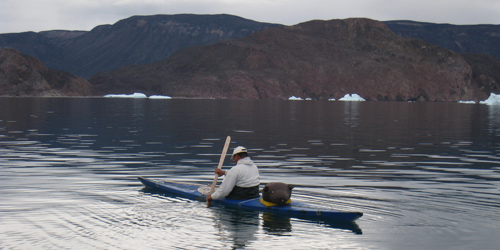
Nothing is really permanent here. People move frequently between places, where opportunities present themselves. Now, the weather was somewhat adverse to hunting, one day was foggy, another too violently rainy to attempt going out. The remaining two days were fine. We went out, spotted some whales, but they are still few in the fjord apparently, and the hunter elegantly slipped into his kayak that was fastened alongside the motorboat, to be untied and put into the water at the sight of game. The hunters are not allowed to hunt directly from the motorboat up here; also they must harpoon it, not shoot it, to get it. The hunter did not catch any narwhal that day, but I could see how the hunt itself implied total concentration and a lot of patience – lying in wait on the sea for the narwhals to surface again. In the accompanying pictures, you can see both the island village and the hunter in his kayak. I also include a picture of the interesting sight of a dream-city just off the island, which appeared on the foggy day – and certainly redeemed it. Now, a few days later, the narwhals have finally decided to take possession of the fjord – they are there in hundreds now, but as elusive as ever.
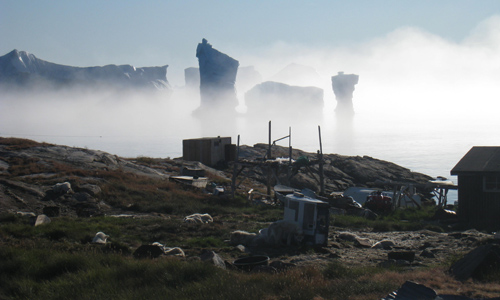
May 2010
Greetings from 78o North -- Northwest Greenland
I am back in a world of winter, even if the sun never sets now. The spring season is still dominated by the activities on the sea-ice, where the hunt for seals takes place all year round. Right now, when the sea is opening up, the so-called ice-edge is getting closer to the village, which simply means that one may reach it within a day on dog-sledge. From the ice-edge the hunters go for bearded seals, walrus and even narwhal - at least in some places. It all depends on when and where the opening is, and where the whales are of course. I had the privilege of being able to join a hunting party that set out for the ice-edge, some 8 hours away (on that particular day).
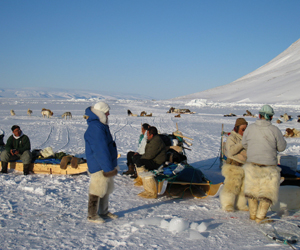 You can see my arrival on the first picture, where the party is having tea before setting up camp. The sledges are turned into sleeping platforms, covered with reindeer skin, and a burlap tent is raised above it.
You can see my arrival on the first picture, where the party is having tea before setting up camp. The sledges are turned into sleeping platforms, covered with reindeer skin, and a burlap tent is raised above it.
You can see how on the second picture. We stayed there for three days and three nights, catching voluminous bearded seals - but no walruses, which was their dream.
A stray polar bear would not have been amiss either.

The challenge right now is to assess the quality of the sea-ice. In spring, and now at unpredictable moments, it melts down from both above and below, and is very fragile in some places. On another lengthy trip to a remote settlement, the ice cracked in some places, forcing dogs and people to jump over. Even the dogs found it difficult and some would land in the icy water, as you can see on the third picture.
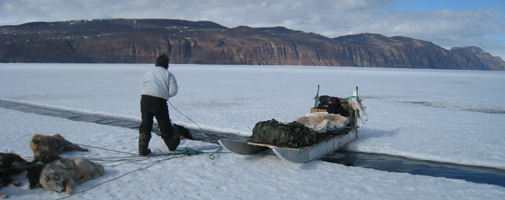
Once the sledge was in place (thanks to the dogs and the agile hunter), I could walk over it - on shaking legs. It is a challenging way of life, and it is a delight to share a tiny fragment of it.
